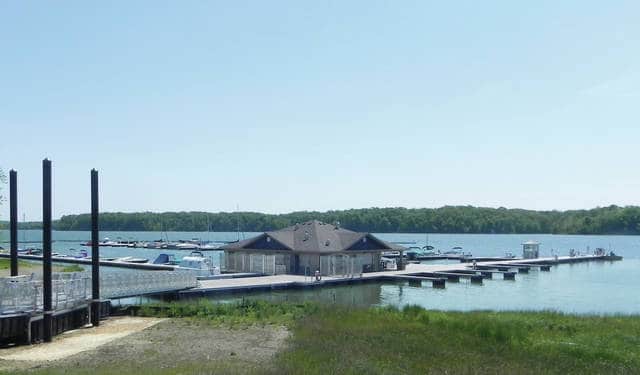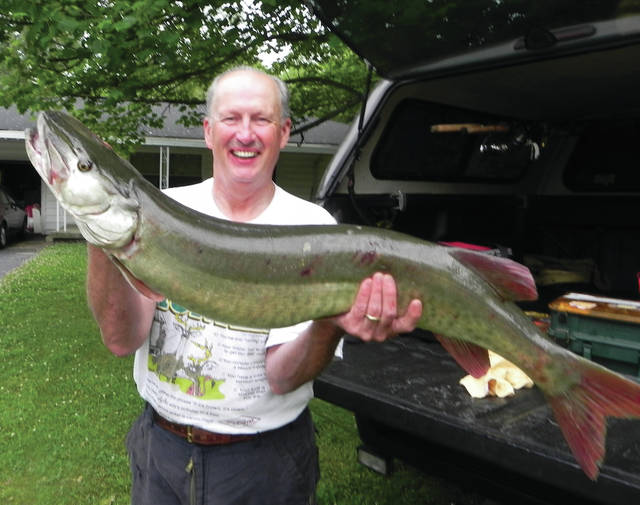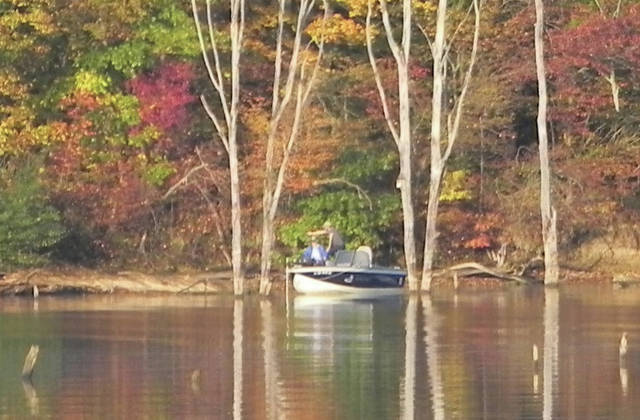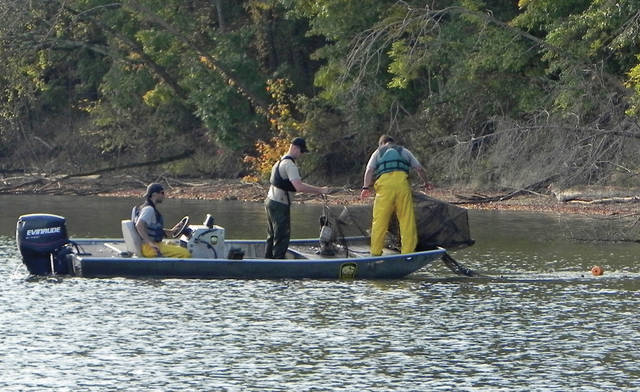




It’s hard to believe it’s been almost forty years since Caesar Creek Lake was built. It is a multi-purpose reservoir designed for flood control, water quality, and recreation. The area that is now the lake and surrounding wildlife area, was a regular victim of spring flooding. The US Army Corps plans for the lake would mean an end to the impact of the floods. Congress authorized Caesar Creek Lake under the Flood Control Act of 1938.
It encompasses about 2600 acres at the normal summer pool level. Construction of the dam began in October 1971 and the gates were closed to start filling in January 1978. Caesar Creek is the deepest inland lake in Ohio with a depth of 115 feet near the dam. While under control of the Louisville District of the U.S. Army Corps of Engineers, the Division of Wildlife provides resource management of the fishery and wildlife area.
Adding to the recreational use of the lake is the marina which was opened in the spring of 2016. The marina, which is a unique design for Ohio, is built to float with the fluctuating water level due to the flood control requirement. The marina features a full service store with zero-ethanol 91-octane marine fuel plus a pump out station along with shower and rest room facilities. There are 112 in water slips available. The slips are leased based on an annual lottery with 20% of slips available each year. There are 10 slips which are for transient overnight use.
Five boat ramps offer access to the lake. The Wellman Prairie Ramp, located off Oregonia Road south of State Route 73, provides convenient access to favorite fishing spots in the southern end of the lake. The State Parks and Watercraft ramp at the campground is great when fishing the northern part of the lake. Many maps show the Haines Road boat ramp on the northeast side of the lake just south of New Burlington Road. Haines Road has recently been renamed to Young Road so some map and GPS confusion may result.
It provides access to some fine early spring crappie and Muskie habitat. The channel winds its way to the main lake and often has significant vegetation growth especially in the summer months. The North Pool boat is often very busy. The waves and boat traffic can make loading the boat a little tricky here.
The lake offers a variety of fish structure from the creek tributaries to steep shores and into the deeper water at the southern end of the lake. There are plenty of gravel and sandy areas that form small bays around the lake. The coves still have a large number of standing timber and brush. Fishermen should use caution as many trees have now rotted off just below the water’s surface.
Caution should also be used in the spring following heavy rains as there will often be trees and larger debris in the lake. A quality lake map plus electronic equipment will provide a significant aid in both navigation and locating fish. Older county maps showing the roads before the lake was built are a good source for locating the road beds for some “hidden” structure.
Crappie fishing is especially good in the spring during the spawn. The crappie will be in the abundant tree tops and brush lines that dot the lake. Division of Wildlife creel surveys indicate that the crappie catch rate has been steadily improving since 2012. The average length reported is just over ten-inches. A favorite destination of many crappie fishermen is the big cove, known locally as Jonas Run, on the east side of the lake just north of the Pioneer Village.
One of the lake’s islands is in this area. Fishermen should pay particular attention to the buoys and their depth-finder as Jonas Run area has some especially shallow areas. Late summer trolling the various points and shelves on the edge of deeper water often produces larger crappie.
The white bass run into the Anderson Fork and Caesar Creek tributaries each spring is an especially popular time. Later in the summer white bass can often be spotted chasing shad in the open water. Division of Wildlife surveys indicate a good population of 8 to 11-inch white bass with a fair number ranging up to about 14-inches.
Largemouth bass are also found throughout the lake. The Division of Wildlife conducted electro-fishing surveys for Largemouth Bass in 2016. The results show continued improvement in the bass population with 58% of the netted fish being 12-inches or greater. The reported bass angler catch rates in 2012 were the best in several years. The outlook for the bass fisherman continues to be good but real lunkers may be scarce.
A significant success story for Caesar Creek Lake is the continued growth of the saugeye and Muskie fisheries. Both species have been intensely managed and stocked by the Division of Wildlife. There have been over 6.6 million saugeye fingerlings stocked between 2000 and 2013. Beginning in 2013 a project was started to evaluate the effectiveness of stocking fry rather than the smaller fingerlings.
The project involved stocking 2.8 fry in 2013 and 2015 with about 281,000 fingerlings being stocked in 2014 and 2016. The fall 2016 netting survey showed good numbers of legal-sized 15 to 19-inch saugeye. Lots of anglers cast crankbaits, jigs or blade baits in May and June. Trolling is an effective method to target saugeye. The outlook for the saugeye fishery continues to be very promising.
Muskie fishing is the hot topic and causing quite a splash at Caesar Creek. The stocking program began in 1998 but it was about ten-years before Muskie were noticed by fishermen. Between 2800 and 5600 advanced fingerling Muskie from the Kincaid Fish Hatchery have been stocked each year over the last five years. Since 2010, when 108 Muskies were reported on the Muskie Angler log the numbers have continued a solid upward trend with 175 catches reported in 2016. The largest reported was 50-inches, which is just shy of the decades old state record of 50.25-inches. This year has been a fast start with the numbers exploding over the last few months.
Through July 137 Muskie have been caught at Caesar Creek. The largest reported was 49-inches with an average length of 34.9-inches.The fall promises to be a great time to target the Muskie, which can be found in a number of places around Caesar Creek. Many anglers prefer casting a variety of crank baits, spinners and top water lures while others troll with success. I believe it’s only a matter of time, and official reporting, before a new state record Muskie will be taken at Caesar Creek.
The lake is large enough that it is difficult to learn all the fish patterns and habitat even after a number of years fishing. Crappie, white bass, Muskie, saugeye and black bass fishermen all have their favorite locations on the lake depending on the season. It is common to encounter fishermen targeting the different species in the same areas. During the fall and winter months, the lake level is lowered to prepare for the storage of heavy spring rainfall. Lake level and water flow information is found online at the US Army Corps of Engineers Louisville District.
Additional information regarding Muskie fishing is found at www.ohiodnr.gov/muskielog. I’ll be on Caesar Creek Lake this fall. Perhaps I’ll see you there!
.neFileBlock {
margin-bottom: 20px;
}
.neFileBlock p {
margin: 0px 0px 0px 0px;
}
.neFileBlock .neFile {
border-bottom: 1px dotted #aaa;
padding-bottom: 5px;
padding-top: 10px;
}
.neFileBlock .neCaption {
font-size: 85%;
}








